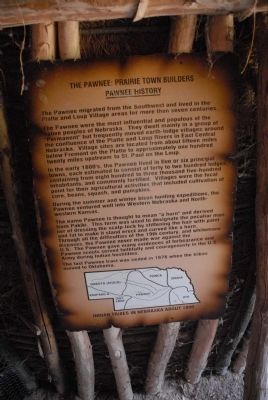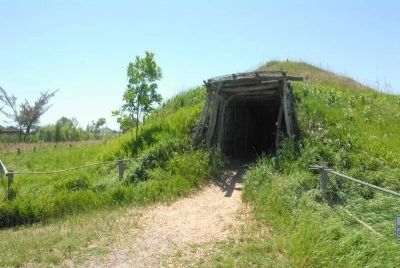The Pawnee: Prairie Town Builders, Pawnee History
The Pawnee were the most influential and populous of the native peoples of Nebraska. They dwelt mainly in a group of “Permanent” but frequently moved earth-lodge villages around the confluence of the Platte and Loup Rivers in East Central Nebraska. Village sites are located from about fifteen miles below Fremont on the Platte to approximately one hundred twenty miles upstream to St. Paul on the Loup. In the early 1800’s, the Pawnee lived in five or six principal towns, each estimated to consist of forty to two hundred lodges containing from eight hundred to three thousand five-hundred inhabitants, and commonly fortified. Villages were the local point for their agricultural activities that included cultivation of corn, beans, squash, and pumpkins.
During the summer and winter bison hunting expeditions, the Pawnee ventured well into Western Nebraska and Northwestern Kansas.
The name Pawnee is thought to mean “a horn” and derived from Pakiki. This term was used to designate the peculiar manner of dressing the scalp-lock by stiffening the hair with paint and fat to make it stand erect and curved like a horn. Through all the difficulties
of the 19th century, and white mans diseases, the Pawnee never made war against the U.S. The Pawnee gave many evidences of forbearance and Pawnee scouts served faithfully and courageously in the U.S. Army during Indian hostilities. The Last Pawnee tract was ceded in 1876 when tribes moved to Oklahoma.Topics. This historical marker is listed in this topic list: Native Americans. A significant historical year for this entry is 1876.
Location. 40° 52.876′ N, 98° 22.509′ W. Marker is on Grand Island, Nebraska, in Hall County. Marker is at the intersection of Tech Ave. and U.S. 34 on Tech Ave.. Located at the mouth of the Pawnee Earthen Lodge at the Stuhr Museum of the Prairie Pioneer. Touch for map. Marker is in this post office area: Grand Island NE 68801, United States of America. Touch for directions.
Other nearby markers. At least 8 other markers are within 4 miles of this marker, measured as the crow flies. Earth Lodge Design and Construction (here, next to this marker); Old California Overland Trail (about 300 feet away, measured in a direct line); Mormon Trail (about 700 feet away); La Grande Isle (approx. 1.6 miles away); Original Home of the Stolley Family (approx. 1.6 miles away); Oldest Remaining School House (approx. 1.6 miles away); Grand Island Public School Bell (approx. 3.2 miles away); Pioneer Park (approx. 3.2 miles away). Touch for a list and map of all markers in Grand Island.
Credits. This page was last revised on June 16, 2016. It was originally submitted on July 29, 2011, by Charles T. Harrell of Woodford, Virginia. This page has been viewed 827 times since then and 17 times this year. Photos: 1, 2. submitted on July 29, 2011, by Charles T. Harrell of Woodford, Virginia. • Bill Pfingsten was the editor who published this page.

